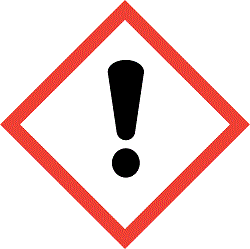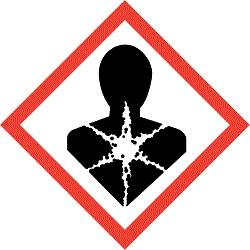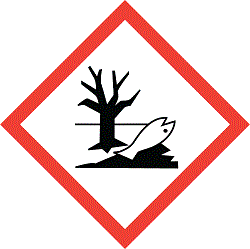
Example 7
The purpose of this example is to show calculation of Reproductive toxicity according to Regulation (EC) No 1272/2008 (CLP).
There is a liquid mixture consisting of the following ingredients:
| Ingredient | Conc. % (w/w) | Classification | Specific Conc. Limits, M-factors and ATEs |
| Substance A | 1.3 |
Carc. 1A: H350i Repr. 1A: H360Df STOT RE 1: H372 Skin Sens. 1: H317 Aquatic Acute 1: H400 Aquatic Chronic 1: H410 |
− |
| Substance B | 6.6 |
Repr. 1A: H360Df STOT RE 2: H373 Aquatic Acute 1: H400 Aquatic Chronic 1: H410 |
− |
| Substance C | 11.0 |
Repr. 1B: H360Df STOT SE 3: H335 Eye Dam. 1: H318 |
Repr. 1B: H360Df: C ≥ 14 % Repr. 1B: H360D: 10 % ≤ C < 14 % Eye Dam. 1: H318: C ≥ 36 % Eye Irrit. 2: H319: 22 % ≤ C < 36 % |
| Substance D | 2.7 | Repr. 1B: H360FD | Repr. 1B: H360FD: C ≥ 3.1 % |
| Substance E | 0.2 | Repr. 1B: H360F | − |
| Substance H | 2.8 | Repr. 2: H361d | − |
| Substance K | 5.5 |
Repr. 2: H361f Aquatic Chronic 4: H413 |
− |
| Substance M | 1.7 |
Repr. 2: H361 Lact.: H362 |
− |
| Water | 68.2 | − | − |
Calculation of mixture classification.
Following ingredients are classified as serious damage to eyes / eye irritation:
| − | Substance C: Eye Dam. 1: H318. |
The mixture's pH is between 2 and 11.5, this does not lead to classification 'Eye Dam. 1'. Mixture contains no ingredients leading to the application of non-additivity approach, therefore, Additivity approach is applied.
Cut-off limits
| − | For serious damage to eyes / eye irritation the cut-off limit 1 % is applied (CLP, Annex I, Table 1.1). Concentration of substance C is above this value, therefore, it is taken into account. |
Calculation of 'Eye Dam. 1'
| − | Concentration of substance C is below its specific concentration limit 36 %. This does not lead to classification 'Eye Dam. 1'. |
Calculation of 'Eye Irrit. 2'
| − | Concentration of substance C is below its specific concentration limit 22 % (lower border for 'Eye Irrit. 2'). This does not lead to classification 'Eye Irrit. 2'. |
Classification of the mixture
The mixture is not classified in category serious damage to eyes / eye irritation.
Following ingredients are classified as respiratory / skin sensitisers:
| − | Substance A: Skin Sens. 1: H317. |
Cut-off limits
| − | There is no generic cut-off limit for respiratory and skin sensitisation (CLP, Annex I, Table 1.1), therefore, any concentration of an ingredient with such classification is taken into account. |
Specific and Generic concentration limits
| − | Because no specific concentration limits are applied for substance A and only A is classified as 'Skin Sens. 1' only its concentration should be compared to generic concentration limits. |
Calculation of 'Skin Sens. 1'
| − | Concentration of substance A is above the generic concentration limit 1.0 % (CLP, Annex I, Table 3.4.5). Because no sub-categorisation is required this leads to classification Skin Sens. 1 . |
Selection of hazard category
| − | The mixture is classified as 'Skin Sens. 1'. |
Selection of hazard statements
| − | H317 corresponds to 'Skin Sens. 1'. |
Selection of pictogram and signal word
| − | Pictogram GHS07 and signal word 'Warning' correspond to 'Skin Sens. 1'. |
Selection of precautionary statements
| − | For H317 following precautionary statements are applied: P261, P272, P280, P302+P352, P333+P313, P321, P362+P364, P501. |
Following ingredients are classified as carcinogens:
| − | Substance A: Carc. 1A: H350i. |
Cut-off limits
| − | There is no generic cut-off limit for carcinogenicity (CLP, Annex I, Table 1.1), therefore, any concentration of an ingredient with such classification is taken into account. |
Specific and Generic concentration limits
| − | Because no specific concentration limits are applied for substance A its concentration must be compared to generic concentration limit. |
Calculation of 'Carc. 1A'
| − | Concentration of substance A is above the generic concentration limit 0.1 % (CLP, Annex I, Table 3.6.2). This leads to classification Carc. 1A . |
Selection of hazard category
| − | The mixture is classified as 'Carc. 1A'. |
Selection of hazard statements
| − | H350i corresponds to 'Carc. 1A' because of substance A. |
Selection of pictogram and signal word
| − | Pictogram GHS08 and signal word 'Danger' correspond to 'Carc. 1A'. |
Selection of precautionary statements
| − | For H350i are applied the same precautionary statements as for H350: P201, P202, P280, P308+P313, P405, P501. |
Following ingredients are classified as reproductive toxicants:
| − | Substance A: Repr. 1A: H360Df. |
| − | Substance B: Repr. 1A: H360Df. |
| − | Substance C: Repr. 1B: H360Df. |
| − | Substance D: Repr. 1B: H360FD. |
| − | Substance E: Repr. 1B: H360F. |
| − | Substance H: Repr. 2: H361d. |
| − | Substance K: Repr. 2: H361f. |
| − | Substance M: Repr. 2: H361 / Lact.: H362. |
Cut-off limits
| − | There is no generic cut-off limit for reproductive toxicity (CLP, Annex I, Table 1.1), therefore, any concentration of an ingredient with such classification is taken into account. |
Specific and Generic concentration limits
| − | Because no specific concentration limits are applied to substances A, B, D, E, H, K and M their concentrations should be compared to generic concentration limits. |
| − | Substance C has specific concentration limits. Because specific concentration limit has a precedence over generic concentration limit, concentration of substance C should be compared to its specific concentration limits. |
Calculation of 'Repr. 1A'
| − | Concentration of substance A is above the generic concentration limit 0.3 % (CLP, Annex I, Table 3.7.2). This leads to classification Repr. 1A . |
| − | Concentration of substance B is above the generic concentration limit 0.3 % (CLP, Annex I, Table 3.7.2). This leads to classification Repr. 1A . |
Calculation of 'Repr. 1B'
| − | Concentration of substance C is below its specific concentration limit 14 % for 'Repr. 1B' with hazard statement H360Df. This does not lead to classification 'Repr. 1B'. |
| − | Concentration of substance C is above its specific concentration limit 10 % a lower border for 'Repr. 1B' with hazard statement H360D. This leads to classification Repr. 1B . |
| − | Concentration of substance D is above the generic concentration limit 0.3 % (CLP, Annex I, Table 3.7.2). This leads to classification Repr. 1B . |
| − | Concentration of substance E is below the generic concentration limit 0.3 % (CLP, Annex I, Table 3.7.2). This does not lead to classification 'Repr. 1B'. |
Calculation of 'Repr. 2'
| − | Concentration of substance H is below the generic concentration limit 3.0 % (CLP, Annex I, Table 3.7.2). This does not lead to classification 'Repr. 2'. |
| − | Concentration of substance K is above the generic concentration limit 3.0 % (CLP, Annex I, Table 3.7.2). This leads to classification Repr. 2 . |
| − | Concentration of substance M is below the generic concentration limit 3.0 % (CLP, Annex I, Table 3.7.2). This does not lead to classification 'Repr. 2'. |
Calculation of 'Lact.'
| − | Concentration of substance M is above the generic concentration limit 0.3 %. This leads to classification Lact. . |
Selection of hazard category
| − | Classification sub-category 'Repr. 1A' is more severe than 'Repr. 1B' and 'Repr. 2', therefore, mixture is classified as 'Repr. 1A'. Mixture is also classified as 'Lact.'. |
Selection of hazard statements
| − | Because substances A, B, C, D, K and M have influence on classification, hazard statements H360Df, H360D, H360FD, H361f, H361 and H362 are taken into account. |
| − | The uppercase letter 'F' has precedence over lowercase letter 'f', some hazard statements have also 'D', therefore, both 'F' and 'D' must be indicated. H360 is resulted from 'Repr. 1A' and is used instead of H361, which is resulted from less severe 'Repr. 2'. Following elements should be combined: H360, F and D. This leads to the use H360FD . |
| − | H362 is resulted from 'Lact.' and must also be indicated. |
Selection of pictogram and signal word
| − | Pictogram GHS08 and signal word 'Danger' correspond to 'Repr. 1A'. |
| − | No pictogram and signal word are applied for 'Lact.'. |
Selection of precautionary statements
| − | For H360FD following precautionary statements are applied: P201, P202, P280, P308+P313, P405, P501. |
| − | For H362 following precautionary statements are applied: P201, P260, P263, P264, P270, P308+P313. |
| − | For both H360FD and H362 following precautionary statements are applied: P201, P202, P260, P263, P264, P270, P280, P308+P313, P405, P501. |
Following ingredients are classified as specific target organ toxicity – single exposure (STOT SE):
| − | Substance C: STOT SE 3: H335. |
Cut-off limits
| − | For 'STOT SE 3' the cut-off limit 1 % is applied (CLP, Annex I, Table 1.1). Concentration of substance C is above this value, therefore, it is taken into account. |
Specific and Generic concentration limits
| − | Because no specific concentration limits are applied to substance C, its concentration should be compared to generic concentration limit. |
Calculation of 'STOT SE 3: H335'
| − | Concentration of substance C is below the generic concentration limit 20 % (CLP, Annex I, 3.8.3.4.5). This does not lead to classification 'STOT SE 3: H335'. |
Classification of the mixture
The mixture is not classified in category specific target organ toxicity – single exposure.
Following ingredients are classified as specific target organ toxicity – repeated exposure (STOT RE):
| − | Substance A: STOT RE 1: H372. |
| − | Substance B: STOT RE 2: H373. |
Cut-off limits
| − | There is no generic cut-off limit for STOT RE (CLP, Annex I, Table 1.1), therefore, any concentration of an ingredient with such classification is taken into account. |
Specific and Generic concentration limits
| − | Because no specific concentration limits are applied to substances A and B, their concentrations should be compared to generic concentration limits. |
Calculation of 'STOT RE 1'
| − | Concentration of substance A is below the generic concentration limit 10 % (CLP, Annex I, Table 3.9.4). This does not lead to classification 'STOT RE 1'. |
Calculation of 'STOT RE 2'
| − | Concentration of substance A is between 1 % and 10 % of the generic concentration limit (CLP, Annex I, Table 3.9.4). This leads to classification STOT RE 2 . |
| − | Concentration of substance B is below the generic concentration limit 10 % (CLP, Annex I, Table 3.9.4). This does not lead to classification 'STOT RE 2'. |
Selection of hazard category
| − | The mixture is classified as 'STOT RE 2'. |
Selection of hazard statements
| − | H373 corresponds to 'STOT RE 2'. |
Selection of pictogram and signal word
| − | Pictogram GHS08 and signal word 'Warning' correspond to 'STOT RE 2'. |
Selection of precautionary statements
| − | For H373 following precautionary statements are applied: P260, P314, P501. |
Following ingredients are classified as hazardous to the aquatic environment:
| − | Substance A: Aquatic Acute 1: H400 / Aquatic Chronic 1: H410. |
| − | Substance B: Aquatic Acute 1: H400 / Aquatic Chronic 1: H410. |
| − | Substance K: Aquatic Chronic 4: H413. |
Cut-off limits
For 'Aquatic Acute 1' and 'Aquatic Chronic 1' cut-off limit is calculated according to formula 0.1/M (CLP, Annex I, 4.1.3.1):
| − | There is no M-factor in Table 3 of Annex VI to CLP established for substance A. Person responsible for classification decided to use M = 1 for both 'Aquatic Acute 1' and 'Aquatic Chronic 1'. Concentration of substance A is above 0.1 % (0.1/1), therefore, A is taken into account for calculation of both 'Aquatic Acute 1' and 'Aquatic Chronic 1'. |
| − | There is no M-factor in Table 3 of Annex VI to CLP established for substance B. Person responsible for classification decided to use M = 1 for both 'Aquatic Acute 1' and 'Aquatic Chronic 1'. Concentration of substance B is above 0.1 % (0.1/1), therefore, B is taken into account for calculation of both 'Aquatic Acute 1' and 'Aquatic Chronic 1'. |
For Aquatic Chronic categories 2-4 the generic cut-off limit 1 % is applied (CLP, Annex I, Table 1.1):
| − | Concentration of substance K is above 1 %, therefore, it is taken into account. |
Specific and Generic concentration limits
Neither specific nor generic concentration limits are applied for acute toxicity.
Calculation of 'Aquatic Acute 1'
| − | Concentrations of substances A and B must be multiplied by their corresponding M-factors and obtained values must be summed.
(M × conc. A) + (M × conc. B) = (1 × 1.3) + (1 × 6.6) = 7.9 The obtained value is below 25 % (CLP, Annex I, 4.1.3.5.5.3.1 and Table 4.1.1). This does not lead to classification 'Aquatic Acute 1'. |
Calculation of 'Aquatic Chronic 1'
| − | Concentrations of substances A and B must be multiplied by their corresponding M-factors and obtained values must be summed.
(M × conc. A) + (M × conc. B) = (1 × 1.3) + (1 × 6.6) = 7.9 The obtained value is below 25 % (CLP, Annex I, 4.1.3.5.5.4.1 and Table 4.1.2). This does not lead to classification 'Aquatic Chronic 1'. |
Calculation of 'Aquatic Chronic 2'
| − | Concentrations of substances A and B must be multiplied by their corresponding M-factors and multiplied by 10. Obtained values must be summed.
(M × 10 × conc. A) + (M × 10 × conc. B) = (1 × 10 × 1.3) + (1 × 10 × 6.6) = 79 The obtained value is above 25 % (CLP, Annex I, 4.1.3.5.5.4.2 and Table 4.1.2). This leads to classification Aquatic Chronic 2. |
Calculation of 'Aquatic Chronic 3'
| − | Concentrations of substances A and B must be multiplied by their corresponding M-factors and multiplied by 100. Obtained values must be summed.
(M × 100 × conc. A) + (M × 100 × conc. B) = (1 × 100 × 1.3) + (1 × 100 × 6.6) = 790 The obtained value is above 25 % (CLP, Annex I, 4.1.3.5.5.4.3 and Table 4.1.2). This leads to classification Aquatic Chronic 3. |
Calculation of 'Aquatic Chronic 4'
| − | Concentrations of substances A, B and K must be summed.
conc. A + conc. D + conc. K = 1.3 + 6.6 + 5.5 = 13.4 The obtained value is below 25 % (CLP, Annex I, 4.1.3.5.5.4.4 and Table 4.1.2). This does not lead to classification 'Aquatic Chronic 4'. |
Selection of hazard category
| − | Classification category 'Aquatic Chronic 2' is more severe than 'Aquatic Chronic 3', therefore, mixture is classified as 'Aquatic Chronic 2'. |
Selection of hazard statements
| − | H411 corresponds to 'Aquatic Chronic 2'. |
Selection of pictogram and signal word
| − | Pictogram GHS09 corresponds to 'Aquatic Chronic 2'. No signal word applies. |
Selection of precautionary statements
| − | For H411 following precautionary statements are applied: P273, P391, P501. |
signal word and P statements
| Classification categories | Classification | H statements | Pictograms | Signal words | P statements |
| Respiratory / Skin sensitisation | Skin Sens. 1 | H317 |  GHS07 |
Warning | P261, P272, P280, P302+P352, P333+P313, P321, P362+P364, P501 |
| Carcinogenicity | Carc. 1A | H350i |  GHS08 |
Danger | P201, P202, P280, P308+P313, P405, P501 |
| Reproductive toxicity | Repr. 1A Lact. |
H360FD H362 |
 GHS08 |
Danger | P201, P202, P260, P263, P264, P270, P280, P308+P313, P405, P501 |
| Specific target organ toxicity - repeated exposure | STOT RE 2 | H373 |  GHS08 |
Warning | P260, P314, P501 |
| Hazardous to the aquatic environment | Aquatic Chronic 2 | H411 |  GHS09 |
− | P273, P391, P501 |
According to Article 20(3) of CLP if both signal words are applied, 'Danger' is used.
Classification and labelling of the mixture
| Classification: | Skin Sens. 1, Carc. 1A, Repr. 1A, Lact., STOT RE 2, Aquatic Chronic 2 |
| Hazard statements: | H317, H350i, H360FD, H362, H373, H411 |
| Pictograms: |  |
| GHS07 | |
 |
|
| GHS08 | |
 |
|
| GHS09 | |
| Signal word: | Danger |
| Precautionary statements: | P201, P202, P260, P261, P263, P264, P270, P272, P273, P280, P302+P352, P308+P313, P314, P321, P333+P313, P362+P364, P391, P405, P501 |
According to Article 28(3) of CLP if mixture has more than 6 precautionary statements, supplier should select among of them the most important 6 statements that should be indicated on the label. The same selected statements should be placed in section 2.2 'Hazards identification' of safety data sheet (SDS). The rest may be placed in section 16 'Other information' of SDS.